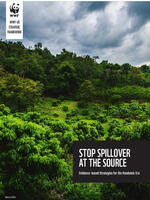Forests are indispensable to human health. Forests provide natural resources, such as food, fiber, and fuel, that support people’s health and livelihoods. They also filter our air, regulate water cycles, and help mitigate the hazardous effects of climate change through carbon sequestration. But the relationship between healthy people and forests goes deeper.
Forests can reduce risks of cardiovascular diseases, cancers, chronic respiratory diseases, and mental health issues, resulting in better, longer, and more equitable health outcomes. In fact, preventing forest loss and degradation is our most cost-effective means of preventing infectious disease outbreaks, such as COVID-19. Forests also protect against physical hazards, such as flooding and extreme weather, and other health issues that endanger human lives.
However, the importance of forests to human health is not reflected in public funding, philanthropy, health-care systems, insurance models, or land-use planning priorities. To protect human health, biodiversity, and the global climate, decision-makers must prioritize forests and advocate for collaborative conservation as a public health strategy.
The scientific evidence demonstrates that public health and forests are entwined—at the local, regional, and global scale—and that across each of nature’s contributions to human health, forest conservation, protection, and management can improve human lives. And when we consider the public health challenges we face in our communities, counties, and countries, we must examine the health implications of how we treat our forests—and how they treat us.





 Craig Beatty
Manager, Forest Strategy and Research
Craig Beatty
Manager, Forest Strategy and Research
 Kerry Cesareo
Senior Vice President, Forests
Kerry Cesareo
Senior Vice President, Forests
 Martha Stevenson
Senior Director, Strategy & Research, Forests
Martha Stevenson
Senior Director, Strategy & Research, Forests
 Annika Terrana
Director, Forests
Annika Terrana
Director, Forests
 Pablo Pacheco
Global Forests Lead Scientist, Global Science
Pablo Pacheco
Global Forests Lead Scientist, Global Science